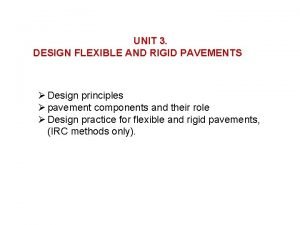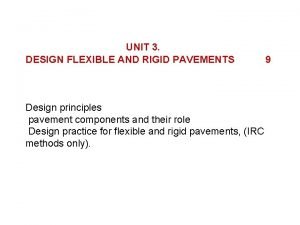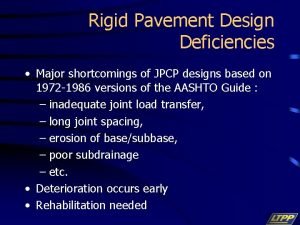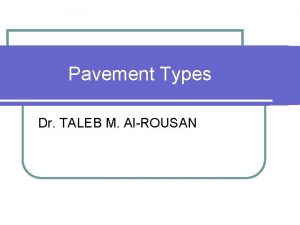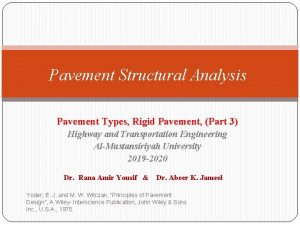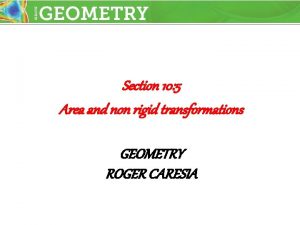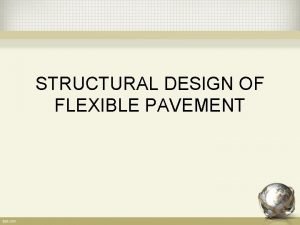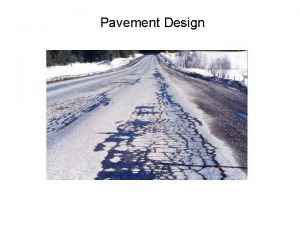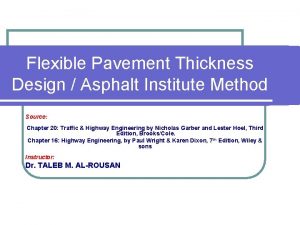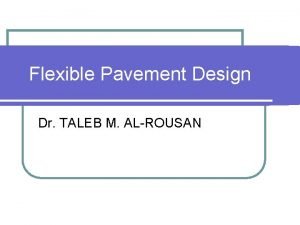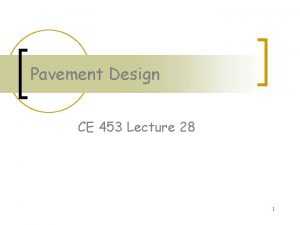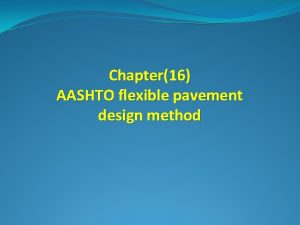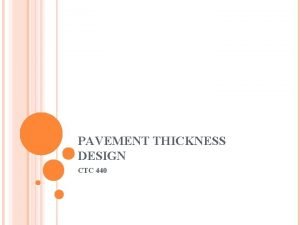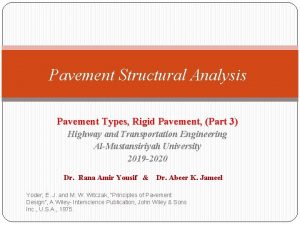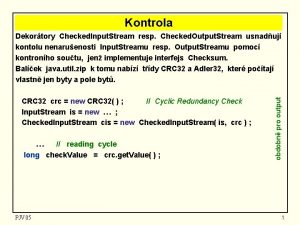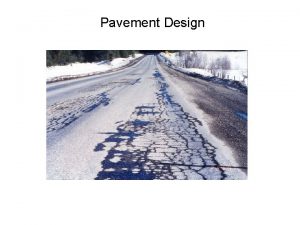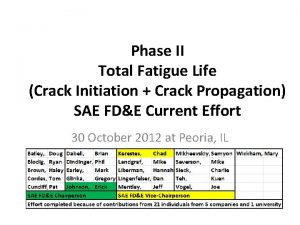Crack Pattern Development Rigid Pavement Design Course CRC

































- Slides: 33

Crack Pattern Development Rigid Pavement Design Course

CRC Pavement Vetter, C. P. 1933 • Reinforced Concrete ´ Drying Shrinkage ´ Temperature Drop Consider a unit Length (L) between cracks a. is restrained by the reinforcement b. Causes tension in concrete & compression in the steel. c. Bond stress between steel & concrete and the concrete & subgrade Rigid Pavement Design Course

(1) Bond stress in the vicinity of crack (2) Compression in steel and tension in the concrete increases until steel = concrete. In this region there is no bond slip or stress. d. Subsequent crack form in concrete when bond stress exceeds the concrete tensile strength. Rigid Pavement Design Course

Longitudinal Joint Traverse Crack CL L ‘t’ Free Edge Rigid Pavement Design Course

Crack Asfsc A s fs A c ft Section XX Section YY Forces Acting on CRC Pavement Section Probable Strain Distribution Adjacent to a Crack Rigid Pavement Design Course

Extensive bond slip Good bond Crack L/2=n. Smin Rigid Pavement Design Course

Crack width: equation 2. 10 a Smin Compression Tension Strain Steel strain or (L-2 x)/2 Crack width: equation 2. 10 b Unrestrained shrinkage strain Concrete strain Rigid Pavement Design Course

L Condition of no stress c b/2 h Stressed, full restraint cw c. g. of bond Steel stress Concrete Stresses and Strains in Fully Restrained, Cracked Reinforced Concrete for Decreasing Temperature Rigid Pavement Design Course

Assumptions of Vetter Analysis 1. 2. Volumetric ‘s are uniformly distributed. Compatibility exists in bonded region. 3. Total bond force= Total Tensile Force= Total change in the steel stress 4. Total length of steel will remain unchanged. Total elongation = Total shortening 5. Equilibrium exists between forces at crack & the forces in the fully bonded region. • In partially bonded region; compatibility of deformation does not exist. • Crack width results from relative displacement between the steel and the concrete. Rigid Pavement Design Course

f sz fsz CL of Crack Compression Te n o si T en ns x 1 a) Steel Stresses ftz io n Tension b) Concrete Stresses u Bond Stress x Bond Stress L c) Bond Stresses Stress Distribution Between Cracks Subject to Shrinkage Rigid Pavement Design Course

(1) Center of crack spacing (2) Bond Force = Concrete tensile force = Change in steel force (3) Total length of steel bars remain unchanged total shortening= total elongation Rigid Pavement Design Course

Total Shortening = Total Elongation Note Rigid Pavement Design Course

For temp. drop Both Rigid Pavement Design Course

Tension a) Steel Stresses CL of Crack b) Concrete Stresses u Bond Stress y Bond Stress L c) Bond Stresses Stress Distribution Between Cracks Subject to Temperature Drop Rigid Pavement Design Course

(1) Center of crack spacing (2) Bond Force = concrete tensile force = change in steel force (3) Total length of steel bars remain unchanged total shortening= total elongation Rigid Pavement Design Course

For temp. drop Both Rigid Pavement Design Course

Average Crack Spacing (ft) 20 Pavements Placed During Winter = Summer = 18 16 12 8 4 0 2 3 4 5 6 7 Ratio of Steel bond Area to Concrete Volume x 10 -2 (in. 2/in. 3) Rigid Pavement Design Course Relationship Between Steel Bond Area and Crack Spacing

Development Length Allowable Bond Stress Design Strength of the Bar ACI Definition of Development Length (a) Assumed and Actual Bond Stress-Slip Relationships. Rigid Pavement Design Course

Development Length Actual Bond Stress Vetter Allowable Bond Stress Force in Bar Under Working Stress Condition Stress Transfer Length (b) Rigid Pavement Design Course

Actual bond Stress-Slip Relationship As Modeled in Computer Program Bond Stress Relative Slip Between Concrete and Steel (c) Rigid Pavement Design Course

concrete tension specimen steel bar (a) a b P • x-Displ. • Slip • (b) ACI x (c) Sb Determination of Slip from Strain Functions Rigid Pavement Design Course

Rigid Pavement Design Course

Rigid Pavement Design Course

Relative to temperature drop Max. drop to cause L = 2 x substitute for in equation For a greater temp. drop t 2……only if otherwise Rigid Pavement Design Course

Rigid Pavement Design Course

Rigid Pavement Design Course

Structural Response Models Uniform Bond Stress Distribution Vetter: Shrinkage and Temperature Drop Zuk: Shrinkage Friberg: Temperature Drop Rigid Pavement Design Course

Hughes: Shrinkage and temperature Drop (concrete only) Rigid Pavement Design Course

CRCP-2: Computer Model for Shrinkage and Temperature Drop (force equilbrium) Regression Equations: Rigid Pavement Design Course

Non-Uniform Bond Stress Distribution TTICRCP: Computer model for Shrinkage and Temperature Drop (force Reis: Shrinkage and Temperature Drop Um u L Percent Steel (p) ; prevent yielding ; p=pmin fs=fy Rigid Pavement Design Course x

2002 AASHTO Guide CRC Design K 2 K 1 Rigid Pavement Design Course

Crack Width Rigid Pavement Design Course

Crack Spacing Distribution %P v c. spc Rigid Pavement Design Course
 Flexible pavement
Flexible pavement Standard axle load for pavement design
Standard axle load for pavement design Difference between rigid and flexible pavement
Difference between rigid and flexible pavement Aashto rigid pavement design spreadsheet
Aashto rigid pavement design spreadsheet Transverse joint
Transverse joint Nh road cross section
Nh road cross section Flexible pavement cross section
Flexible pavement cross section Types of rigid pavement
Types of rigid pavement Base subbase subgrade
Base subbase subgrade Rigid vs non rigid transformations
Rigid vs non rigid transformations Rigid dam
Rigid dam Rigid transformation
Rigid transformation Aashto flexible pavement design calculator
Aashto flexible pavement design calculator Asphalt pavement design example
Asphalt pavement design example Asphalt pavement design example
Asphalt pavement design example Asphalt pavement design example
Asphalt pavement design example Aashto flexible pavement design
Aashto flexible pavement design Asphalt pavement design example
Asphalt pavement design example Cdfu meaning
Cdfu meaning Site:slidetodoc.com
Site:slidetodoc.com Reliability factor table
Reliability factor table Objectives of pavement design
Objectives of pavement design Flexible pavement design / aashto method example
Flexible pavement design / aashto method example Dfaringe
Dfaringe Faa pavement design software
Faa pavement design software Cut brick lengthwise
Cut brick lengthwise Course number and title
Course number and title Chaine parallèle muscle
Chaine parallèle muscle Error detection and correction in networking
Error detection and correction in networking Crc in computer networks
Crc in computer networks Crc in computer networks
Crc in computer networks Htc crc pitt
Htc crc pitt Crc card diagram
Crc card diagram Crc diagram
Crc diagram
